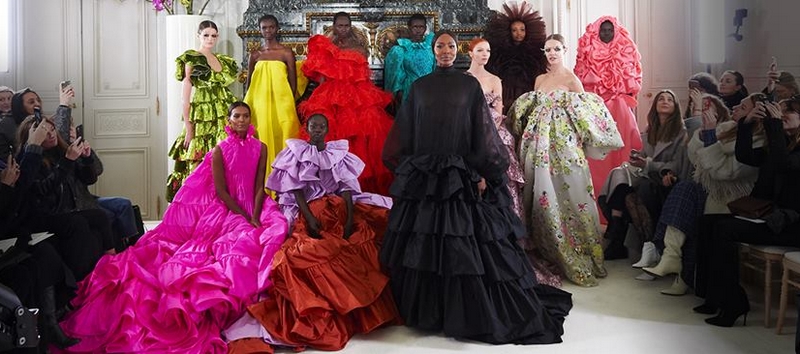A year on from the red carpet protests of 2018, the most striking thing about this year’s awards season so far has been their absence.
The 2019 Golden Globes focused on Lady Gaga’s enormous Valentino dress rather than the handful of #TimesUpx2 badges. So as Hollywood prepares for Sunday’s Screen Actors Guild (SAG) awards and next month’s Oscars, will the political rhetoric of 2018 have crystallised into something in which clothes still play a part?
Red-carpet predictions are still wide open. The Golden Globes suggests a split between two camps – grown-up trousers (see Julia Roberts in black Stella McCartney cigarette trousers) and fantasy gowns, like that worn by Lady Gaga, hinting at some division as to where we are 12 months after the carpeted #MeToo protests.

This week’s Vanity Fair Hollywood issue, another good indicator, points towards red frou frou gowns for women, and black tie (but no ties) for men. But it’s the spring couture shows, which also happened this week in Paris, that are probably most instructive, and this season evenly split between trousers and fantasy.
Clare Waight Keller of Givenchy, one of the most discussed brands in modern couture, opened her collection with a pair of latex trousers, while Armani Privé, one of the most widely worn red carpet labels, featured a record nine pairs of trousers. Both are hotly tipped awards favourites.
While Valentino, Dior, Balmain and Schiaparelli all focused on enormous fairtytale pieces, which may play a role on Sunday, it is Viktor & Rolf’s verbal slogans, “Give a damn”, “Get mean” and “No”, appliqued on huge tulle gowns that could have the biggest impact if worn..
Couture rarely reflects the real world, but this year, in showing both sides of the coin it suggests both trends were possible and, for once, the catwalk and reality were in conversation.
Carolyn Mair, a fashion psychologist, said: “By wearing trousers, you’re making a statement about gender fluidity, that you don’t want to be objectified. But floaty dresses, especially the fantasy ones, and provided they aren’t overtly sexualised, give an equally powerful statement of ‘I can dress like this, but it doesn’t give you a right to touch me’.”

It’s a marked change from 2018. In the immediacy of MeToo, and with the birth of the TimesUp movement, last year’s Golden Globes red carpet was an all-black tide of visual protests. It was the same at the Baftas. The Oscars, though low on political clamour and high on colour, was heavy with TimesUp pins and Black Lives Matter badges.
Alexandra Mandelkorn, the US stylist who dressed Janelle Monae for the Globes, said: “I’ve been seeing less black this year … and a growing spotlight on gender fluidity in the past few years.” She attributed this to women reclaiming power on the catwalk.
Mair agreed, saying: “The issues certainly peaked last year, that’s undeniable. But as we can see from the news, the fallout is still going on, and the movement has been almost normalised, so how the red carpet will reflect that is anyone’s guess. Last year’s ‘black out’ felt like a trend which had momentum, but the problem is, the people who drive the industry don’t want it to carry on.”
The relationship between Hollywood and fashion that has been thoroughly ingrained for years is now even more so. Speaking in Paris last week, Kim Jones, artistic director at Dior, said designers not only work with the red carpet in mind, but that it was often their most public platform. “It’s a good way to show people an idea of [what you are doing],” added the British designer.

Trousers first began to be seen on the Hollywood red carpet in the early 1960s when the studio system was dissolving and second-wave feminism was starting. Although Barbara Streisand wore a jumpsuit to collect her best actress Oscar in 1969, it wasn’t until Jane Fonda’s black Yves Saint Laurent suit three year later, a visual reminder of campaigns against the Nixon administration as well as a shift in her identity, that trousers really became acceptable. Faye Dunaway then wore trousers in 1977, Jodie Foster won an oscar in beige Armani in 1992, and Julia Roberts wore a men’s Armani suit at the Golden Globes in 1990.
As ever, sales are key, with catwalk-to-commercial, an increasingly powerful aspect. Both trends are in keeping with what sells, said Liane Wiggins, of Matchesfashion.com .“For SS19, we have been focusing on this idea of a ‘demi-couture’ approach,” she said, which includes trouser suits.
Mair said: “It’s interesting to see what happens, but the idea that people aren’t actually looking at the clothes, even if you wear a suit, is naive. The forgettability of an outfit is a move in itself. Hollywood and fashion both know that.”
guardian.co.uk © Guardian News & Media Limited 2010
Published via the Guardian News Feed plugin for WordPress.


